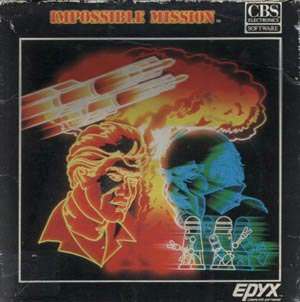
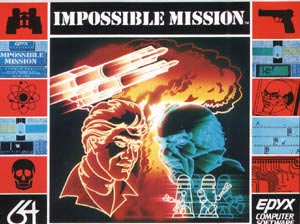


"Another visitor. Stay a while. Stay forever!". The chilling words of Elvin Atombender that greeted you upon entering his underground fortress at the start of "Impossible Mission". How did you get into this mess now, you wonder? By being the best. You are Agent 4125, assigned with the task of preventing the world's destruction within the next 6 hours. Better get on with it I suppose.
In 1983, Epyx unleashed one of the greatest ever games onto an unsuspecting Commodore 64 audience. Designed by Denis Caswell, it obviously took its name from that 60s TV series, but really threw the plot around.
The plot centres around Elvin, a quiet man at first until he went to college. There, his mind was warped upon failing to clock an arcade machine because the power failed. Vowing vengeance, he spent the next few years gaining qualifications in AI, robotics and engineering, and then disappeared 8 years ago. Until now. It was a few years ago that many banks had noticed large sums of money had been electronically stolen from their systems. Elvin was the culprit and had used the money to construct a large underground base from which to run his operations. He had also designed and built many intricate security devices to protect his palace. These have already cost the lives of two of your fellow agents. Using the knowledge at his disposal and the use of a self-constructed supercomputer, Elvin plans on breaking and triggering the codes that control the world's nuclear arsenal. The time is currently midday. The Pentagon estimate Elvin will have cracked the codes by 1800 hours and launch the missiles. Due to the security in place, the only item you have been able to smuggle into the base is a small portable computer.
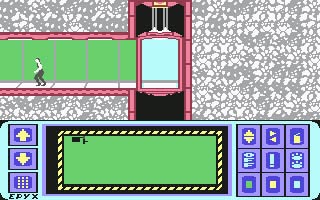
The first thing you notice upon entering is that this is no ordinary hideout. Rooms run off many lift shafts throughout the construction. Within each room, platforms seemingly hang in mid-air, large gaps waiting to catch unwary people. Occasionally you may come across large sentry balls that track your every move. And then there are the human seeking robots. Devilishly clever that Elvin. Approximately 1.4 meters tall and running on wheels, they have a nasty tendency to do the unexpected. They also shoot long streams of electricity. Problem is you can never really tell what sort of programming the robot has until you are potentially within shooting range. Some just sit there and watch you. Others may track you and fire randomly. A few paranoid types look over their shoulders to check behind them. And then there are the real nasty bar stewards who zoom about at Mach 3 shooting enough charge to power a small village. Fortunately you are pretty agile, with a decent running speed and a quality somersault to hopefully get you out of any immediate danger. All this still doesn't quite help the matter of trying to negotiate some really bizarre and complex layouts to reach the pieces of furniture in each room.
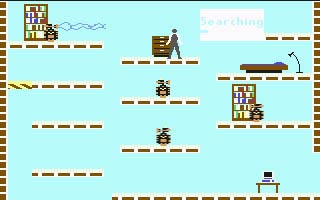
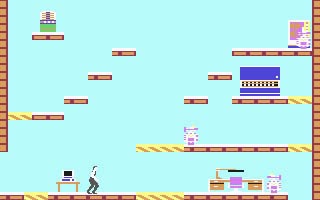
Ah yes, the furniture. Elvin may be a genius, but he is also very absent-minded. Access to his control room, the target of your insurgence, consists of a 9 letter password. Each letter is in the form of an old-fashioned punchcard, and each card has been broken into 4 pieces. These pieces have been scattered about in the chairs, tables, vending machines, toilets and other appliances in the hideout. There are 32 rooms in total to visit, so good hunting, and watch your back!
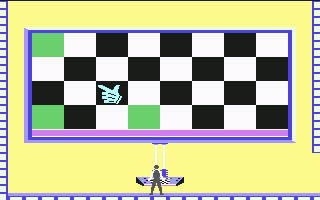
Fortunately you do have some help to call upon. Searching each piece of furniture will reveal one of four outcomes: nothing, a password piece, a snooze control or a lift reset. Snoozes will temporarily disable the robots within a room allowing you some time to search unmolested. Lift resets will put the lifts back to their original location, useful if you've fallen off somewhere and need to get back up. There are also two password rooms to discover, where you play a musical game to earn either snoozes or lift resets. And yes, you probably will need them all, so play well.

Once you have found all 36 password pieces, your job is only half completed. I've seen people have no problems doing the collecting, but just fall apart on this stage. This is the reason for smuggling the computer in, to help you reassemble the password into its original form. You use the icons to manipulate each piece so that its colour and rotation are correct and match it with 3 other pieces so that they form a complete punchcard. Sounds easy? Let me tell you, it is not. There is no simple solution, and many pieces will quite easily fit with several others available. You need a keen eye and some logical guesswork to solve this stage. Fortunately many pairs of correct pieces will form regular shapes from which to work off, and once you get a couple of punchcards out of the way, it gradually becomes easier as the possible combinations drop. And once you've finally done all that, you can proceed to stop Elvin's diabolical plans. Why this idea hasn't been used since is a mystery, as it is such an original concept.
So why is the game a classic? For a start it was at least 5 years ahead of its time. At least until its sequel came around. For a game originating in 1983, the birth of the C64 essentially, it is a masterclass in how a game should be put together, tweaked and stuffed into 64K. Though I do have the feeling the speech was only put in because enough room was left afterwards to do it. But who is complaining when that generates so much atmosphere? Besides the opening burst from Elvin, you hear your agent scream as he falls down a hole or gets fried. Plus Elvin will tell his robots to kill you every time the hour mark goes past. And then scream back when you finally foil his efforts. Sound is limited to spot effects, robots doing their business and the echoing footsteps of your agent as he runs around the lair. Atmospheric if anything, it conveys an immense feeling of being alone against a serious amount of cold steel.
Graphically the game is rather superb, the animation of your agent is almost rotoscope quality and the robots just ooze menace and tension. The backgrounds are simple but effective, and give you enough idea of how to move about each level. The attention to detail on the furniture is uncanny, sometimes with many rows of vending machines, or the loo roll next to the toilet. And yes, that is searchable as well! The game is challenging, but not impossible as the title says but it takes a lot of practice to get that far. You just feel the need to have another go, and then another, and then sometime later look up and find 6 hours have gone by with you trying to defeat the damn program. That is how it was at first. Ten minutes doesn't seem like much, but it all starts to add up when you make a few mistakes in a row and the time really gets going. And trying desperately to fit all the puzzle pieces together before it all falls apart. Maddening. A case of gameplay winning over looks, except here the graphics and sound are superb as well. There is absolutely nothing to fault the game on whatsoever.
Well almost. The original CBS version has a nasty bug in it that can really screw your game up. If the pattern of a robot calls for it to fire at the end of the platform and that platform is on the left hand edge of the screen, when it does so it will fry the agent no matter where he is in the room. Good huh? The US Gold release fixed this little problem by preventing the robots from firing in this situation. Apparently the problem was brought about by a glitch from running the NTSC version on a PAL machine.
At least in that situation you were still able to complete the game, albeit with some swear words and a few extra snoozes. Poor Atari 7800 owners couldn't even manage that as there were only 35 puzzle pieces to collect in the game, making it truly impossible to finish. Which is a pity because that version isn't too bad. The same can be said for the BBC version, which is probably the closest of any to matching the original. Not often you hear that now about the BBC! Graphically very close, if not sonically, it also played well using the keys instead. Or so I recall from having a go a long time back at school. But the C64 original is by far the best one to go for. It won many awards including "Game of the Year 1985" from the BMA (British Micro-computing Association).
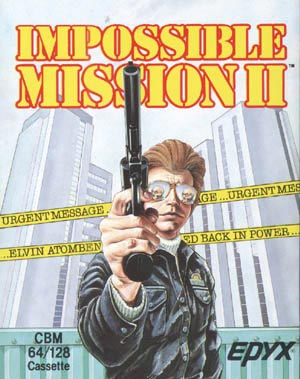
Then of course, there is the sequel five years on. They say people never change. In the case of Elvin Atombender, this is just so. After escaping and recouping his losses, Elvin has established himself in a new 8 tower complex intent on blowing up the world once more. And those vital passcodes are hidden inside various objects around the towers. But that is all that is the same this time.
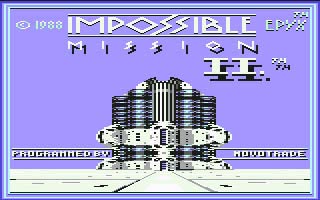

Each tower is made up of 5 or 6 rooms, so overall there are not all that many more rooms to visit. And you don't necessarily have to search each room either. Each tower has its own theme, so you may be searching cars and tyres in one level, and then office equipment in the next. A search on an item will again reveal one of four outcomes: nothing, a passcode, a console utility or an extension of time. But the layouts are a lot trickier than in the original. Elvin must have learnt that, and has made life a lot harder than before. Besides the usual platforms and vertical lifts, there are also horizontal lifts and movable sections to utilise. Some areas you will need explosive methods to reach! All your previous training may count for nothing here. Fortunately in the intervening years you have got better. Not only do you now have 8 hours to save the world, but falling foul of the hazards will only take 6 minutes off the clock instead.
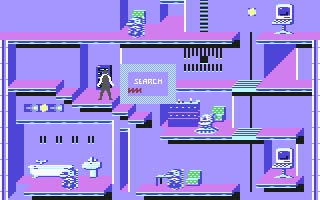
There are also some new adversaries to deal with besides the common sentry bots from before. They have been upgraded as well, making them a tricky prospect around the narrow levels you must traverse. The most annoying new robot has to be the Bashbot, who takes great delight in pushing you off the platform you are on, quite often into empty space. Its deadly cousin, the Suicidebot, fortunately is a lot rarer but will drag you off the platform to both your deaths. Squatbots can be a help and a hindrance, as they offer a temporary way to increase height when jumping, but will be fatal if the ceiling above is too low. Pestbots are annoying little things who ride the platforms endlessly. Non fatal in themselves, however they will often nip a lift away just when you need it, or cause you to move into the line of fire from a Sentrybot. Finally there are Minebots who lay mines along their platform route. Carefully stepping is required to avoid a messy ending.
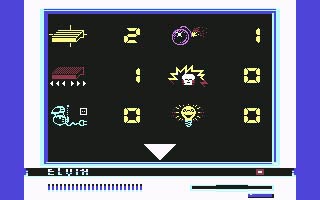
Fortunately you have a bit more help to call upon than previously. Accessing one of the many consoles around the towers will enable access to a number of gadgets. Besides the ubiquitous snooze and lift reset, there are four other items to use. The light bulb will illuminate any dark rooms you may find around the complex. The red platform icon will change the position of some platforms in a room, enabling you to reach otherwise inaccessible areas. The skull icon is a mine that will destroy anything which comes across it. Useful for removing annoying robots or creating vital holes to reach parts of a room. Finally there are timed bombs which are the same as mines but detonate after 4 seconds. These are needed for blowing the safe in each tower.
Within each tower there are two objectives to complete. The first is to collect the correct passcodes to be able to progress to the next tower. These are in the form of coloured digits, which make a 3 digit password. There are many different digits for each colour, so you just have to hope you pick up the right ones from some of the easier objects to reach. Otherwise you are going to be doing overtime to make it to the next tower.
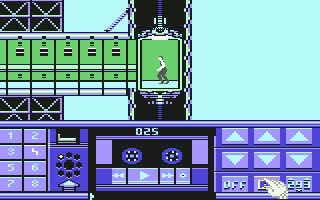
Secondly you must get the piece of music from the safe in each tower. There are 6 unique pieces to collect, and these are required for gaining access to the main control tower and confronting Elvin. Each safe is heavily guarded so some forward planning, cunning, a mine and bomb and usually a snooze or two are needed to get in, blow the safe, grab the music and get out in one piece. After getting the music in a tower and doing much searching for passcodes, you should start to think about trying to get to the next tower. This is where your computer comes in. It will search through your collected passcodes to check if you have the correct digit in each colour to be able to pass to the next tower. If you don't have all 3, better get searching once again. You can also listen to the collected music you have so far. There are two duplicate pieces somewhere, and you will only gain access to the main tower if the tape recorder holds 6 unique pieces, no more, no less. You must use the rewind and play facilities to check if any of the pieces are the same as each other. All the music pieces have the same tune but using different instruments. With some sounding similar, it is not easy to distinguish between them! If you spot a duplicate, position the tape so that the next piece you collect overwrites it. Ingenious.
After completing the eighth tower and having 6 unique pieces of music, you can enter the main control tower. This consists of one room, tricky to negotiate nonetheless with 3 terminals in the middle. One disarms the missiles and saves the day, the other two kill you. Choices, choices. When you do eventually pick the right one, you are treated to the end sequence, which tried to make things as open-ended as possible. Will there be another sequel at any point? Doesn't seem likely sadly, given it is 12 years since the second game came out.
So how does the sequel stand up the original? Pretty well actually. Epyx licensed out the programming to a separate company called Novotrade, and they did a good job in recreating the feel. Certainly there are many improvements made over the original, the graphics for a start. Then on the other hand, the program is 5 years on and you have a multiload to use as well. Still, each tower is suitably detailed as before, with individual pieces of equipment and neat little touches. The robots are inventively designed and animated, though a touch fuzzy at times. Still you know when they are approaching to be able to get out of the way! Sound is identical to before, sadly no new bits of speech or effects to use. Why tamper with something that was excellent to begin with?
Gameplay wise, the essence of the objective switches slightly more towards the collecting side than the puzzle side. There are no real puzzles to actually solve over the top of negotiating the platforms safely. All you have to do is line up the 3 correct passcode digits, and identify duplicate pieces of music. Hardly in the same league as the punchcards of the original. Getting around the platforms is a lot harder admittedly, but this is offset by the fact you can often ignore hard rooms and still continue the game. This, plus the fact you only lose 6 minutes for each mishap means that the game is slightly easier overall. Still a challenge, but not quite so impossible as last time.
As a pairing, the two games are inseparable because what you learn in one, you can transfer to help play the other. On their own, the original just gets the nod from me as the better game, but both are excellent programs you should get out there and play henceforth.